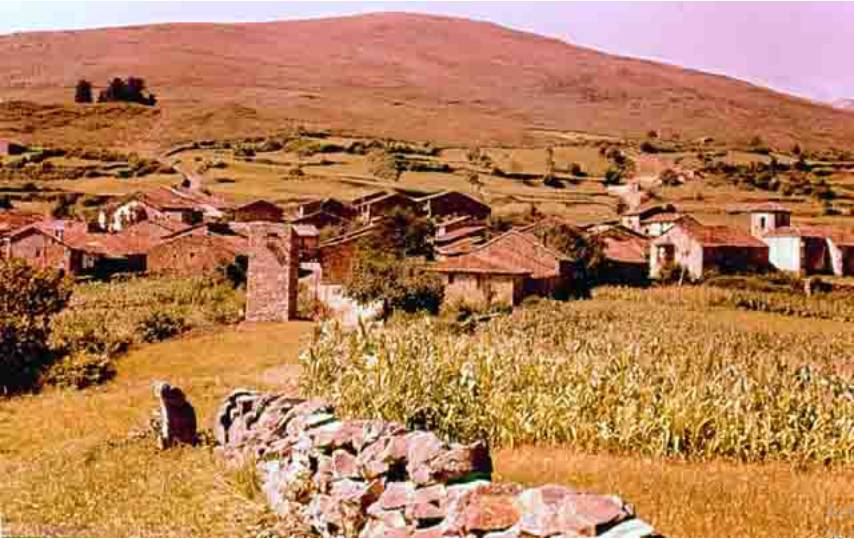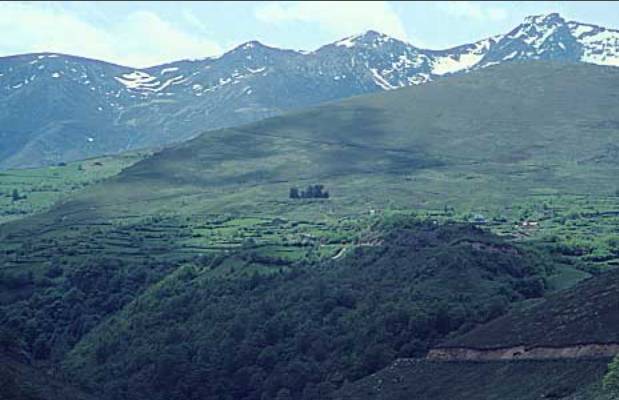Place Too Sacred (Gabriel Garnica)
A Place Too Sacred
Garabandal is where God will put a permanent sign,..His monument for humanity. It would have no room or need for a human edifice.
Reprinted with permission from GARABANDAL International, October-December 2003
by Gabriel Garnica

As often happens with many of the Almighty’s manifestations and messages to His creatures, what seems so simple turns out to be very profound, and, eventually, we come to realize that the original simplicity was for the sake of our limited capacities to comprehend and appreciate just how wonderful our God really is.
While looking through a Canadian Garabandal Website (www.ourlady.ca) recently, I stumbled onto a page called “Sacred Ground”. At first glance, the information and observations contained therein seemed interesting but, with time, the true depth and imposing message this information carried finally seeped into my mind.
In his book Garabandal — Der Zeigefinger Gottes (Garabandal — The Finger of God), Albrecht Weber recounts how, on November 13, 1965 (the day of the last Garabandal apparition), Conchita stated that Mary had referred to the Pines as “sacred” because God loved them very much. This message was again discussed at a stay in the Meson Serafin in October, 1981 and clarified by Conchita’s brother Serafin in July, 2000, one month before his death. According to him, when the girls asked the Virgin whether a church should be built at the Pines, she answered, “No, this place is too sacred. God loves this place very much. I wish that a small white chapel be built, in honor of St. Michael. The big church should be built below, in the valley.”
At first, these words seemed to be an ironic paradox. How could a place be “so sacred” that a church should “not” be built there? “Is not a church exactly what you put in a ‘sacred’ place?” I thought to myself. The Webpage concluded with an explanation by Bishop Rudolf Graber, a professor of mystical theology and a very Marian bishop. According to Graber, our Blessed Mother’s statement is plausible if you consider that a church is a place for honoring God while displaying human vanity. Bishop Graber added that one could deduce that any place where God was going to put a permanent sign, His monument for humanity, would have no room or need for a human edifice.
I had to step back for a few days just to grasp what was being said here. I always had thought of churches as places where one touched God in some way, where the human met the holy, the sacred. Now, I was reading that the Pines were “too sacred” in themselves for a church, that a church should be built below them. I remembered seeing that spot on my visit to Garabandal, but had never heard this particular aspect concerning the chapel and future church.
There is no doubt how strongly the Garabandal Message and events called for respect and appreciation of the Church both in a universal and in a structural form. One can easily recall how the children acted in the village church and how Mary herself respected the Church by stopping locutions at the door when entry during these events was forbidden. This was clearly not a dismissal of respect for churches and their important place in our faith. What was being said here was far more profound, more meaningful, and more revealing about both our human nature and our future than I initially realized.
Meeting God on Our Terms
Despite the fact that churches can be vital, and beautiful, manifestations and embodiments of our faith, they ultimately remain such manifestations and embodiments on our terms. We generally decide the size, shape, and setup of our churches. We make them as ornate, or as simple, as our desire and interpretation of faith takes us. Comparing churches in Italy and Spain to many of those found in the US, it sometimes is hard to imagine that the same faith is being practised within. Many of the churches I saw in Europe were ornate, artistic, visual songs of praise to our God. There were graphic images of the Crucifixion and the crucified Christ. While there are exceptions in the United States, for the most part our churches are much less ornate, graphic, and visual.
So we see that churches are glasses through which our image and appreciation of our faith is seen. We can tell a lot about a community by the type, size, style, and expense revealed in its church. Things such as the relative wealth and priorities of a parish are evident in its church. Even changes in liturgy and practice are evident in a church. This was evidenced by the removal of the Communion rails, for example. So we see that despite the fact that a church is our attempt to meet our God, we cannot help but do so on our terms because those terms are part of us, of the way we were raised, of the way we think.

What Churches Cannot Do
St. Francis taught us that there is one thing any church structure cannot do. When he rebuilt the church of San Damiano, this beloved saint took simple stones and generated a church simple in both structure and message. Following the message and teachings of Christ, Francis taught us that it is what is inside the hearts, souls, and minds of the human beings who happen to be inside a church that matters most. The story goes that, once built, this simple church was filled with the spirit of God and the message of Christ in a way that no other fancy, ornate, human structure of faith could touch!
Just as Christ disliked the fancy, pretentious, outward actions of the Pharisees and preferred the simple faith of the poor and humble, so too we must be careful not to judge faith by stone and gold. At the end of the day, it is what we do inside a church and how and why we do what we do inside that church that determines the true measure of our faith! Jesus taught us this much as He overturned the money changers and sellers in the Temple.
What History, The Present, and The Near Future Tell Us
One thing we can learn from history, from the present, and from what is likely to happen in the near future, is that the styles, decorations, monuments, and setups of churches change. Even the liturgy and practice found inside a church is subject to change and interpretation, and is not always proper, appropriate, or even in keeping with true Church teaching. We cannot let the degree of our faith be changed by the placement of the baptismal font or how many statues fill our churches! While these things are important and have their place, our faith must supercede and go beyond that.
We must fight to keep what is good about our faith, but we must also realize the relative importance of external, temporal, man-made things versus internal, eternal things which come from God. It is dangerous, in these times, to allow oneself to be tied to man-made, material, or humanly defined, terms. An example of this is the meaning of “Catholic” or “Christian”, which we have seen twisted and stretched in knots to fit the “needs” and “modern enlightments” of those whose agenda is rationalization, compromise, and selfsatisfaction, and not in following God’s Word.
In God’s Terms
The Garabandal Message tells us that the Pines will be the site of “the greatest miracle that Jesus will have ever performed for mankind. ” We know that this Miracle will be permanent and will come from God. Given what we have said above, it is clear that the Pines is and is destined to forever be a place chosen by God to reach to us.
This must be differentiated from churches, where we attempt to reach to God. The Almighty has chosen the place, and the time, to make His Presence known to us. He has chosen the manner He will do this, and we are called to believe, and to place our faith in Him and follow His commandments and His will.
While the cathedrals and shrines of the world are beautiful reminders and monuments to Our Lord, we await a heavenly monument built by God Himself on His terms, not ours. This place must be apart from the vanity, competition, materialism, and self-worship rampant in our world. From the Pines we can see the town church, and will be able to see the future church on the hill, and we can see the Pines from these churches as well, but there are definitely two levels at play here: our temporal reach for God and His heavenly, eternal reach for us. There is no gold, no fancy architecture, no ornamentation, no expensive organ in the Pines; there is peace, silence, solitude, the whisper of our Creator calling us on His terms.
Conclusion
We have recounted how the Virgin told the children of Garabandal that the Pines is “too sacred” a place on which to build a church. We have explained why this is not a disrespect to churches but rather an appreciation of the fact that churches are reaching for God on our terms.
The Pines, on the other hand, will very clearly be a manifestation of God Almighty reaching for us on His terms. It is said that these nine pines are the surviving result of Serafin’s grandfather’s idea that every child should plant a pine tree in the heights above the village as a symbol of his or her life and in commemoration of his or her first Holy Communion. The symbolism is so rich and clear. Just as the Eucharist leaves its mark in our souls, so too the pines planted in commemoration of the first Eucharist will be the site where the Almighty leaves His mark on mankind on His Terms and in ground too sacred for anything else but The Finger of God.
to order your copy GARABANDAL International
Back for more Garabandal Information


